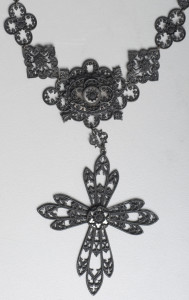Diana Galante, Objects conservator at the National Museum of American History, presented her research on cast iron jewelry conducted at the Straus Center for Conservation and Technical Studies at the Harvard Art Museums (H/AM).
Using objects in the collections of H/AM and the Birmingham Museum of Art (BMA), Diana investigated the art historical records, material nature, alloy composition, and fabrication methods of these pieces. Analytical methods included XRF, SEM-EDX, and FTIR.
Diana began by describing several of the German-made objects, including two necklaces with pendants, a brooch, a pair of earrings and a set of mesh bracelets made with iron wire. Certain elements were attached together with copper rivets. Some pieces had gilt elements and steel beads. Most surfaces were coated with Berliner Lack. The similarities in motifs and methods of construction among the pieces were described.
She then presented the historical use of iron, the development of cast iron technique, alloy compositions, and the resulting physical properties. This was the starting point for determining how cast iron workers were able to make such delicate pieces of jewelry when the material is typically seen as brittle while strong in compression forces. After a thorough review of the literature, Diana theorized that the addition of phosphorous to the alloy enabled the fluidity of the molten metal that allowed for the casting of such thin, delicate pieces.
The historical record of advances in cast iron manufacturing was also discussed. Diana discussed English advances in the field and their influence on Prussian technology. State-sponsored factories in Prussia were able to manufacture everything from cannons and architectural elements to sculptures and home stoves, and they sold their wares to internal and international markets. During the Napoleonic War, Prussian women donated gold jewelry to fund the war effort. In exchange for the gold, they received delicate cast iron jewelry, which they wore with national pride. The jewelry was also worn as mourning jewelry and later became fashionable accessories.
To understand cast iron fabrication techniques,, Diana collaborated with Massachusetts College of Art (MCA) and fabricated cast iron jewelry pieces. She made models of a cast iron out of wax and used a sand-casting technique. Using an old radiator as the source of cast iron metal, Diana estimated how much phosphorus was needed in order to attain the optimal working properties to gain a fluid iron alloy, similar to the cast iron used in the original fabrication. Despite misgivings from MCA collaborators, many of the pieces cast very well and with very fine details, including delicate cross-hatching marks made by Diana’s tools used to sculpt the wax models.
Samples from several additional cast iron jewelry pieces from the BMA were examined in cross section using SEM-EDX analysis. The results provided insight into the alloy composition and structure of the matrix. These investigations were also compared to the alloy from her casting samples.
Diana concluded her talk by commenting on her admiration for the incredible skill of 19th-century cast iron craftsmen in fabricating such beautiful, delicate pieces of jewelry. Understanding how the smelting process, type of furnace and fuel, alloy components, and casting method all influence the final product is a remarkable feat, and are demonstrated in the cast iron pieces she studied at the H/AM and BMA.
